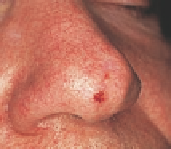Environmental Engineering Reference
In-Depth Information
This long-wavelength
(low-energy) form of UV
radiation causes aging of
the skin, tanning, and
sometimes sunburn. It
penetrates deeply and
may contribute to skin
cancer.
This shorter-wavelength (high-energy) form
of UV radiation causes sunburn, premature
aging, and wrinkling. It is largely responsible
for basal and squamous cell carcinomas
and plays a role in malignant melanoma.
Ultraviolet
A
Ultraviolet
B
Thin layer of
dead cells
Hair
Squamous
cells
Epidermis
Basal
layer
Sweat
gland
Melanocyte
cells
Basal
cell
Dermis
Blood
vessels
Squamous Cell Carcinoma
Basal Cell Carcinoma
Melanoma
This deadliest of
skin cancers
involves melanocyte
cells, which produce
pigment. It can
develop from a mole
or on blemished
skin, grows quickly, and can spread to other
parts of the body (metastasize).
Arising from cells
in the upper layer
of the epidermis,
this cancer is also
caused by exposure
to sunlight or tanning
lamps. It is usually
curable if treated early. It grows faster than
basal cell carcinoma and can metastasize.
The most common
skin malignancy
usually is caused
by excessive
exposure to sunlight
or tanning lamps.
It develops slowly,
rarely metastasizes and is nearly 100%
curable if diagnosed early and treated properly.
Figure 16-18
Science:
structure of the human skin and the relationships between ultraviolet (UV-A and UV-
B) radiation and the three types of skin cancer. (Data from the Skin Cancer Foundation)
which amounts to about 2,300 deaths in the United
States each year.
A third type of skin cancer,
malignant melanoma
(Figure 16-18, right), occurs in pigmented areas such as
moles. Within a few months, this type of cancer can
spread to other organs.
Melanoma kills about one-fourth of its victims
(most younger than age 40) within 5 years, despite
surgery, chemotherapy, and radiation treatments. Each
year it kills about 100,000 people (including 7,400
Americans), mostly Caucasians. The disease can be
cured if it is detected early enough, but recent studies
show that some melanoma survivors have a recur-
rence more than 15 years later.
A 2003 study found that women who visited tan-
ning parlors once a month or more increased their
chance of developing malignant melanoma by 55%.
The risk was highest for young adults. A 2004 study at
Dartmouth College found that people using tanning
beds were also more likely to develop basal cell and
squamous cell skin cancers.
People (especially Caucasians) who experience
three or more blistering sunburns before age 20 are
five times more likely to develop malignant melanoma
than those who have never had severe sunburns.
About one of every ten people who get malignant
melanoma has an inherited gene that makes them es-
pecially susceptible to the disease.






